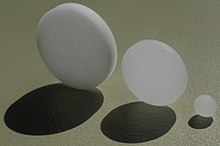Diffuser (optics)
A diffuser or diffusion plate ( latin diffundere , pour ',' scattered ',' propagate ') is an optical component that is used to light to scatter. The effects used here are diffuse reflection and refraction of light. In light measurement technology, high quality diffusers are used to give a detector increased sensitivity for a large solid angle range. In many cases an attempt is made to achieve an angle-dependent sensitivity that follows Lambert's law . In photography , diffusers are used both to scatter the flash light and to receive the light (diffuser lens), see diffuser (photography) .
Structure and mode of operation of a diffuser
It is characteristic of every diffuser that it has a large number of small scattering centers. If parallel rays of light hit different points on a diffuser, they are distributed in different directions and thus generate diffuse light. For applications in the UV range , quartz glass is mainly used in addition to PTFE , the latter having a higher transmission .
A diffuser can cause the light to be scattered on its surface. This happens, for example, when light falls on a white sheet of paper. When viewed microscopically, such a surface is rough. A material in which the scattering effect of the surface is also used is textile, for example when using a light trough .
Diffusers are also often used, which scatter the light within a volume. These diffusers are made of a transparent material such as B. Glass with a large number of "imperfections" such. B. is provided with small air pockets that serve as a scattering center. Whether such a diffuser achieves an emission characteristic that follows Lambert's law depends, among other things. a. on the thickness of the material, the density of the scattering centers and the size of the scattering centers. Milk glass panes are an example of such diffusers . They create a soft light in lampshades , and when used on doors and windows, the light diffusion is used as a privacy screen.
Scattering mechanisms in a volume diffuser
For a simplified model, a volume diffuser made of pure quartz glass ( refractive index n = 1.46) is considered, whereby spherical air bubbles (n = 1.0) are assumed as the scattering centers. The light is scattered by refraction and total reflection. In the case of a volume diffuser with a high number of scattering centers, multiple scattering of an incident light beam is common. Only in this way can a total scatter be achieved which is similar to a Lambert radiator.
Scattering by total reflection
Due to the difference in refractive index between air and quartz glass, total reflection can occur at a critical angle , which contributes to the scattering of the light.
Scattering by refraction
If the light is not totally reflected by the air bubble as described, there is a refraction at both transitions from quartz glass to air and vice versa. This follows Snellius' law of refraction and scatters light in different directions depending on how it hits the same scattering center.
Application example: diffusers in the automotive industry
In classic automobiles there are lenses as part of the headlights . One of the goals is to distribute the light generated by the incandescent lamp asymmetrically in such a way that the edge of the lane is illuminated further than the center of the lane so as not to dazzle oncoming traffic. In contrast to what has been described above, these diffusing screens are mostly made of clear glass, the surface of which is designed so that light is refracted and distributed in the desired way through a series of prisms .
Modern vehicle headlights mostly dispense with lenses for aesthetic reasons. The asymmetrical light distribution is taken over here by the reflector, the headlight delimitation on the light exit surface impresses as a smooth, clear surface made of glass or mostly plastic. In the automotive jargon, however, clear headlight lenses are still colloquially referred to as "diffusers".


